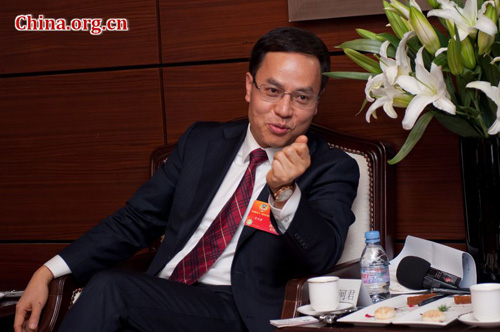Clean energy giant eyes promotion of integrated PV
- By Chen Boyuan
 0 Comment(s)
0 Comment(s) Print
Print E-mail China.org.cn, March 8, 2012
E-mail China.org.cn, March 8, 2012
One of China's leaders in the field of clean energy is set to promote the use of building-integrated photovoltaic technology (BIPV) in order to reduce the reliance of fossil fuels in light of carbon emission reduction targets. (Gallery>>>)
In promoting BIPV, Hanergy Holding Group, China's largest private clean energy products maker, hopes to install thin film solar cells on buildings, which will generate enough power for each building's energy requirements.
|
|
|
Li Hejun is the?chairman of Hanergy Holding Group and also the 11th National Committee member of the Chinese People's Political Consultative Conference. [Photo by Chen Boyuan/China.org.cn] |
Li Hejun, chairman of Hanergy and also the 11th National Committee member of the Chinese People's Political Consultative Conference (CPPCC), the country's top advisory body, noted on Tuesday that, outside industry circles, many, including the general public, remain largely unaware of solar power's potential, mainly because solar power generation in China is still "minimal and therefore easily overlooked."
Unlike traditional power generation, especially thermal power, which is clustered in a relatively limited area, the facilities for solar power generation require a vast area if the effects are to be widely felt in an integrated fashion.
In addition, the feeling among the general public is that BIPV is similar to traditional solar cell modules made of monocrystalline silicon or polysilicon, which require a certain level of light intensity.
However, thin film solar cells possess a low-light power generation capability. Commenting on this capability, Li Hejun stated that thin film solar cells will generate power as long as there is light; the only difference being the amount of power generated.
In his proposal to the government, Li noted that "the total installed capacity for BIPV will reach 1 billion kilowatts by 2020, which is the equivalent of another 368 Gezhouba Dams, or 45 Three Gorges Dam Projects."
"If we install BIPV solar cells to 15 percent of all roofs and south-facing walls, the impact will exceed our wildest imaginings; we are on the threshold of what I call the era of traditional energy replacement. The market demand for solar power has risen annually by 40-50 percent," Li said.
Another advantage of thin film PV cell is its transmittance, which will not affect the lighting inside a building when replacing glass curtain walls in buildings.
"Thin film cells can be customized to different colors to meet our customers' requests, [making them] exactly the same in appearance as glass curtain walls," Li added.
However, Li cautioned that the promotion of BIPV requires more than just industry-wide efforts; it also needs the country's support.
According to Li, the key aspects of government support are tax reduction and exemption. He said: "For example, buildings installed with such solar cells will be exempted from property tax for five to eight years."
"We wouldn't expect subsidies, because it's always difficult to take money from government revenue," he continued. "But it's applicable if they collect less from us," he concluded with a grin.






